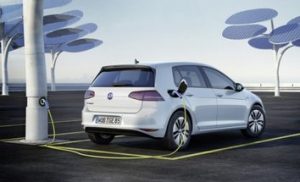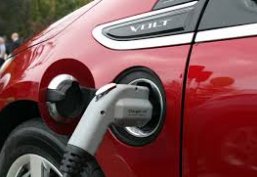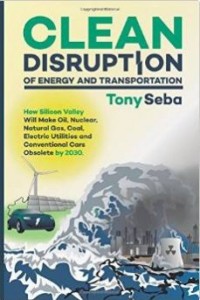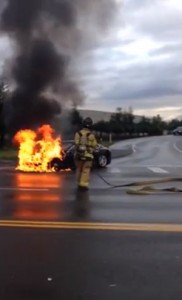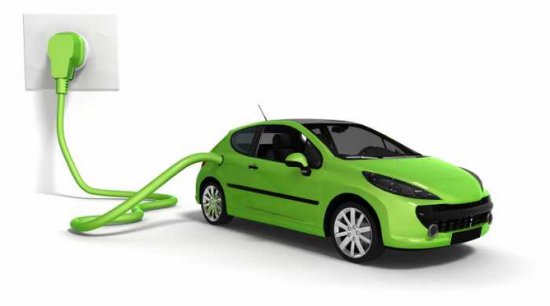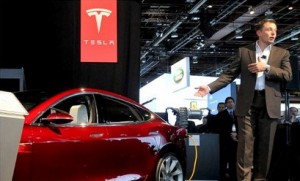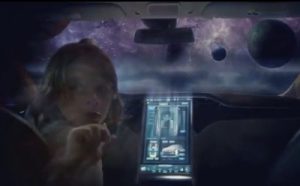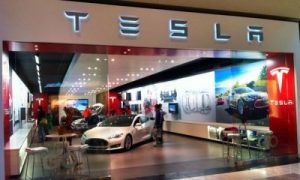by Jon LeSage, editor and publisher, Green Auto Market
Here’s my take on the 10 most significant and interesting occurrences during the past week…….
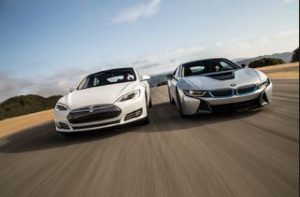 Combining “lightweighting” and advanced batteries could bring Tesla Motors and BMW beyond competition for dominance in the sporty luxury electric car space. Tesla CEO Elon Musk told German weekly Der Spiegel that Tesla and BMW have been in meetings on forming a potential alliance in batteries and light-weight carbon fiber components being used in the BMW i3 and i8. Musk finds the carbon fiber made by BMW and its joint venture with materials supplier SGL “interesting” and “relatively cost efficient.” Musk said the talks are exploring whether collaboration might work for battery technology or charging stations. BMW and Tesla had met in June to discuss creating charging stations applicable to different types of electric vehicles. This alliance could expand Tesla’s recent history of working with major OEMs such as Toyota and Daimler. Toyota is moving away from building its RAV4 EV that uses Tesla’s electric drivetrain, but still wants to work with Tesla; the same is true for Daimler, which recently sold its remaining 4% stake in Tesla but wants to continue to collaborate with electric carmaker.
Combining “lightweighting” and advanced batteries could bring Tesla Motors and BMW beyond competition for dominance in the sporty luxury electric car space. Tesla CEO Elon Musk told German weekly Der Spiegel that Tesla and BMW have been in meetings on forming a potential alliance in batteries and light-weight carbon fiber components being used in the BMW i3 and i8. Musk finds the carbon fiber made by BMW and its joint venture with materials supplier SGL “interesting” and “relatively cost efficient.” Musk said the talks are exploring whether collaboration might work for battery technology or charging stations. BMW and Tesla had met in June to discuss creating charging stations applicable to different types of electric vehicles. This alliance could expand Tesla’s recent history of working with major OEMs such as Toyota and Daimler. Toyota is moving away from building its RAV4 EV that uses Tesla’s electric drivetrain, but still wants to work with Tesla; the same is true for Daimler, which recently sold its remaining 4% stake in Tesla but wants to continue to collaborate with electric carmaker.- Honda will loan $13.8 million to FirstElement Fuel to build 12 more hydrogen fueling stations in California. The hydrogen station supplier received a similar loan of $7.3 million from Toyota earlier this year as part of funding for the first 19 FirstElment stations in California. California wants to have 100 hydrogen stations assembled by 2020. The California Energy Commission granted FirstElement almost $27 million earlier this year; it’s part of a pledge of almost $200 million to bring the 100 fueling stations to the state. Hydrogen stations are expected to expand to other states, including Toyota collaborating on a hydrogen network in the Northeast. Volkswagen, which showed two hydrogen-powered vehicles at the LA Auto Show, is prepared to bring its fuel cell vehicles from Germany to the US market.
- Keith Leech, Fleet Manager at the City of Sacramento and head of Sacramento Clean Cities, has won the 2014 Fleet Excellence (FLEXY) in Public Fleet Sustainability award. “We are the first government fleet in the country that is actually fueling with renewable natural gas (RNG) naturally produced locally from organic food waste using anaerobic digesters that the city did not build. We’re excited to be out in the forefront and support a local start-up company [CleanWorld – a Sacramento Clean Cities partner],”Leech said. Read more about it in NAFA Fleet Management Association’s FLEETSolutions.
- Clean Cities is rolling out a new program to coordinate bulk alternative fuel and advanced vehicle technology orders. Its new Funding Opportunity Announcement (FOA) is called Alternative Fuel and Advanced Vehicle Procurement Aggregating Initiatives. “By developing a process for companies and organizations to consolidate their orders, it could help vehicle manufacturers achieve better economies of scale and lower prices per unit,” Clean Cities says.
- The Sierra Club is joining Ford Motor Co. and SunPower’s Drive Green for Life program to help more Americans move toward emissions-free driving. Ford customers who own electric vehicles such as the Focus Electric, C-Max Energy and Fusion Energy plug-in hybrids, will get a $750 rebate on a SunPower residential solar system. Two other models are eligible for the program, the C-Max Hybrid and Fusion Hybrid. The Sierra Club will be receiving a $500 donation for each rooftop solar system through the program.
- Energy Vision named four winners to its 2014 Leadership Awards in the renewable energy field. Among the winners were Richard DiGia of Aria Energy and Harrison Clay, President, Clean Energy Renewables, whose joint project works with the Seneca Meadows Landfill in Seneca Falls; its first New York State operation converting landfill biogas into vehicle fuel, to ship its renewable natural gas to California, where Clean Energy Renewables distributes it to vehicle fleets.
- The Coda Sedan now has a second life as the Mullen 700e, an unchanged version of the electric car. The Mullen 700e debuted at the LA Auto Show last week. One big difference is that the 31-kilowatt-hour battery pack is now supposed to deliver the car 185 miles on a charge compared to the previous 125 mile range on the Coda Sedan. The car comes from a post-bankruptcy firm named Coda Cars, whose chief executive Rick Curtis now serves as president of Mullen Consolidated, the corporation that’s overseeing the revival of this electric sedan.
- The US Department of Defense and the US Air Force are bringing 42 plug-in electric vehicles to the Los Angeles Air Force Base. The non-tactical vehicle fleet gained a $3 million investment from California Energy Commission and comes from an alliance between federal, state, and private energy organizations, Air Force officials said. The fleet is made up of plug-in sedans, vans, and trucks. It’s also serving as a demonstration model for emerging vehicle-to-grid (V2G) technology. The vehicles can direct power to and from the electrical grid when they’re not being driven. The technology is capable of providing more than 700 kilowatts of power to the grid, which could power more than 140 homes in the US.
- About 280 employers in the US now have workplace electric vehicle charging stations, a number that’s nearly doubled in the past two years. Workplace charging is turning into an effective tactic to attract and retain talented employees while supporting reductions in greenhouse gas emissions and advanced vehicle technologies. Several of these employers are participating in the US Dept. of Energy’s EV Everywhere Workplace Charging Challenge. Starting with 13 founding partners in January 2013, its grown to 150 partners who are providing access to charging stations for more than 600,000 employees at more than 300 worksites around the country.
- Lux Research presented a cost-of-ownership model comparing gasoline and diesel internal combustion engine vehicles to battery electric vehicles (EVs), plug-in hybrid electric vehicles, hybrids, and hydrogen fuel cell vehicles. EVs lead the way due to the relatively low cost of electricity, and it was followed by various types of hybrids, and plug-in hybrids. Rating measures included fuel cost alone, fuel cost plus operation, and purchase or lease for total ownership cost.

